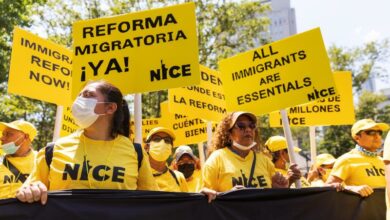Community kitchens help stave off hunger in Peruvian capital’s slums

By Carla Samon Ros
Lima, Apr 28 (EFE).- Higher prices for basic food items, delays in getting nutritional security legislation passed and a drop in private donations are making it more difficult for community kitchens to battle hunger in Lima’s densely populated shantytowns.
Due to the challenges of that triple blow, many of those public spaces have had to ration their supplies and reduce their offering to just one meal per day.
At 10 am at one of these kitchens, “Jardines del Paraiso,” a giant, stove-cooked meal for a hundred residents of the upper part of a hill in Lima’s Villa Maria del Triunfo district is almost ready to serve: a carapulcra (a traditional Peruvian dried potato and pork stew) with 15 kilograms (33 pounds) of rice and some chicken flavoring.
Three meals per day used to be prepared at that kitchen, located inside a building with four plywood walls, a dirt floor and a corrugated iron roof, but now just one is served and the proportion of carbohydrates to protein also has been raised.
The cost customers are charged for each meal also has tripled from 0.5 soles ($0.13) to 1.5 soles.
“Initially, it was breakfast, lunch and an afternoon snack, but now we’re only providing lunches,” coordinator Carmen Norma Julca told Efe while managing an operation that is making do without water and electricity service or government assistance.
“We no longer buy chicken because it’s gotten a lot more expensive. We might just prepare a soup, or green or yellow rice with a fried egg. We can’t buy vegetables, the cost is too high. Even onions, potatoes, everything has gone up (in price),” the 44-year-old woman said while holding her newborn baby in her arms.
Like “Jardines del Paraiso,” most of Lima’s community kitchens sprouted up spontaneously between March and April 2020 when the onset of the coronavirus crisis laid bare the precarious situation of millions of Peruvian families, who had no savings and depended on their daily income to put food on the table.
“People needed to fill their bellies, and we said ‘we’re going to do something,'” Jessyca Laguna, leader of the “Granja de Retamal” community kitchen, also located in Villa Maria del Triunfo, told Efe. “With other residents, we gathered together pots, wood that we didn’t need and started to cook. The need and hunger were so great.”
Estimates are that some 250,000 people in Lima alone have been fed through more than 2,400 neighborhood initiatives of this type that were launched after the onset of the pandemic.
Over time, improvisation gave way to greater planning by what are almost exclusively female-led operations.
While the gradual return to normality has reduced the number of needy people to feed, high inflation now is creating new problems.
At the national level, Peru’s Congress this month passed legislation backed by leftist President Pedro Castillo to waive sales taxes on basic food items.
Earlier, that unicameral body had approved a bill (signed into law Wednesday by the president) that recognizes community kitchens as grassroots social organizations and guarantees their sustainability and financing.
Even proponents of that legislation, however, say it is insufficient because no direct budget support is assigned to the kitchens.
Local legislation also is being considered that would loosen restrictions against the recovery of unsold fresh food at large markets in Lima, some 90 tons of which is disposed of everyday.
For now, though, resilience is the lone path forward for those whose live in hillside districts that, according to Laguna, are “invisible” to Peru’s political elite.
Julca, for her part, also vowed to keep plugging away.
“We see ourselves as brave women who don’t give up and aren’t ashamed to keep asking (for donations) and knocking on doors,” she said. EFE





